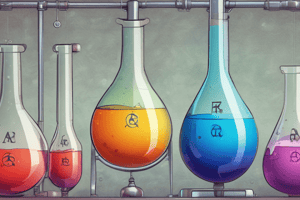Podcast
Questions and Answers
Which substance is classified as a base?
Which substance is classified as a base?
- A substance that accepts protons
- A substance that can be dissolved in water to produce OH⁻ ions (correct)
- A substance that can be dissolved in water to produce H⁺ ions
- A substance that donates protons
What defines a substance as acidic?
What defines a substance as acidic?
- pH > 7
- pH < 7 (correct)
- Presence of OH⁻ ions
- pH = 7
In an acid-base reaction, what is the result of neutralization?
In an acid-base reaction, what is the result of neutralization?
- Increase in pH
- Formation of salt and water (correct)
- Formation of more protons
- Production of hydroxide ions
How are acid-base reactions classified based on strength?
How are acid-base reactions classified based on strength?
What distinguishes strong acids and bases from weak acids and bases in water?
What distinguishes strong acids and bases from weak acids and bases in water?
How is the acidity or basicity of a solution determined?
How is the acidity or basicity of a solution determined?
What relationship is described by the equation pH + pOH = 14?
What relationship is described by the equation pH + pOH = 14?
In what direction does pOH change as pH decreases?
In what direction does pOH change as pH decreases?
What is the significance of understanding acid-base reactions in daily life?
What is the significance of understanding acid-base reactions in daily life?
How does neutralization of stomach acid by baking soda exemplify the importance of acid-base reactions?
How does neutralization of stomach acid by baking soda exemplify the importance of acid-base reactions?
Study Notes
Navigating Acid-Base Reactions: Where Acids, Bases, and Salts Meet
Acid-base chemistry is a fundamental aspect of chemistry, shaping our understanding of how substances interact and react. In this educational exploration, we'll focus on acid-base reactions, delving into the fascinating realm where acids, bases, and salts intersect.
Acids and Bases: Definitions and Properties
An acid is a substance that donates protons (H⁺) or can be dissolved in water to produce H⁺ ions. Conversely, a base is a substance that accepts protons or can be dissolved in water to produce OH⁻ ions. Acids and bases are characterized by their acidic or basic nature, respectively, and are typically classified by their pH values: substances with pH < 7 are considered acidic, while those with pH > 7 are considered basic.
The Concept of Neutralization
Acid-base reactions primarily involve neutralization, which occurs when acids and bases react to form a salt and water. This interaction is characterized by the cancellation of protons. For example, when hydrochloric acid (HCl) reacts with sodium hydroxide (NaOH), hydrogen chloride ions (H⁺) are neutralized by hydroxide ions (OH⁻) to form sodium chloride (NaCl) and water (H₂O).
[ \text{HCl} + \text{NaOH} \rightarrow \text{NaCl} + \text{H}_2\text{O} ]
Acid-Base Reaction Classifications
Acid-base reactions can be classified as either strong or weak. Strong acids and bases completely dissociate in water, whereas weak acids and bases only partially dissociate. The degree of dissociation and the resulting concentration of ions in solution are crucial factors in understanding acid-base reactions and their applications.
The Acid-Base Equilibrium: pH and pOH
The concentration of H⁺ and OH⁻ ions determines a solution's acidity or basicity. The pH scale measures the concentration of H⁺ ions, while the pOH scale measures the concentration of OH⁻ ions. Since pH = -log[H⁺] and pOH = -log[OH⁻], the relationship between pH and pOH is pH + pOH = 14. As pH decreases, pOH increases.
The Importance of Acid-Base Reactions in Daily Life
Acid-base reactions are not just a curiosity in chemistry labs; they have a significant impact on our daily lives. For instance, the neutralization of stomach acid by alkaline-rich substances like baking soda is essential for effective heartburn treatment. Understanding acid-base chemistry helps us appreciate the importance of maintaining proper pH levels in our bodies, as well as the environmental and industrial implications of acid-base reactions.
As you explore the fascinating world of acid-base reactions, remember that the key to understanding this chemistry lies in the balance of protons, the principles of neutralization, and the relationships among acids, bases, and salts. With this knowledge, you'll be able to delve deeper into the chemical world and harness the power of acid-base reactions for a variety of applications.
Studying That Suits You
Use AI to generate personalized quizzes and flashcards to suit your learning preferences.
Description
Test your knowledge on acid-base reactions by exploring the definitions, properties, neutralization concept, classifications, equilibrium, and real-life applications of acids, bases, and salts. Learn about the pH scale, pOH scale, strong and weak acids/bases, and the significance of maintaining proper pH levels in daily life.




